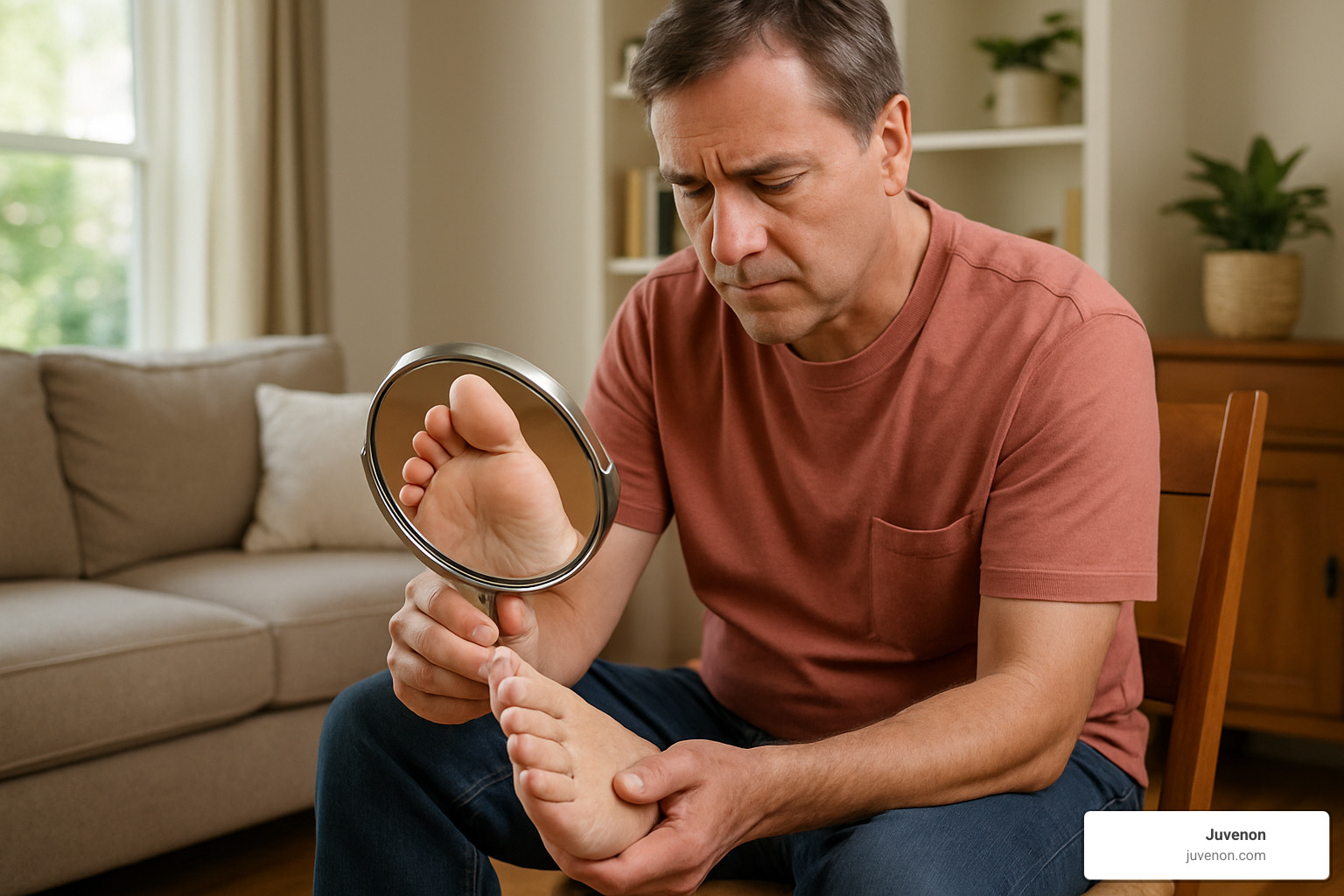
If you're concerned about diabetes early stage poor circulation in feet pictures, here's what to look for in early stages:
- Skin color changes - pale, bluish, or reddish discoloration
- Hair loss on feet and lower legs
- Shiny, thin skin texture
- Slow-healing cuts or scratches
- Cold feet compared to rest of body
- Weak or absent pulses in feet
- Mild swelling around ankles
- Dry, cracked skin on heels and soles
Diabetes early stage poor circulation in feet pictures can reveal these subtle changes before they progress to serious complications. When diabetes affects your blood vessels, it can damage the tiny capillaries that supply oxygen and nutrients to your feet. This reduced blood flow often shows visible signs before you feel symptoms, making visual inspection critical for early detection.
Poor circulation in diabetic feet is surprisingly common - affecting approximately 33% to 50% of people with diabetes during their lifetime. What makes this particularly dangerous is that many people don't notice these changes until significant damage has occurred.
I'm Michelle M. Henson, and as a copywriting leader for healthy aging supplements with extensive experience researching diabetes early stage poor circulation in feet pictures, I've learned how crucial early visual identification can be in preventing serious complications.

Diabetes Early Stage Poor Circulation in Feet Pictures: Spot the First Clues

Your feet often whisper warnings long before they scream for help, especially when you have diabetes. Learning to spot these early visual clues isn't just helpful—it could save your limbs. The Foundation for Peripheral Neuropathy tells us that a staggering 40 million Americans deal with some form of peripheral neuropathy, with diabetes being the leading cause.
I recently spoke with Dr. James Morton, a podiatrist who's dedicated his career to diabetic foot care. He shared something fascinating: "Most patients are genuinely shocked when I show them pictures of early circulation problems. Those subtle changes they've been brushing off for months? They're actually waving red flags for serious trouble ahead."
When examining diabetes early stage poor circulation in feet pictures, look for these telling signs:
The first hint is often a subtle bluish or purplish tint to your toes, particularly noticeable when your feet are hanging down. Your skin might look unusually shiny and smooth, as if slightly stretched. Many people also notice hair disappearing from their toes and the top of their foot—a small change with big implications. Your toenails might become thicker and more brittle, sometimes changing color. And at day's end, you might spot mild swelling around your ankles that wasn't there in the morning.
What makes these changes so dangerous is their gradual onset—they creep up so slowly that they're easy to miss if you're not actively looking for them. This is exactly why having reference pictures to compare with your own feet can be such a valuable tool.
Color Changes, Temperature Drops, and Swelling
One of the most reliable early warning signs is color change in your feet. A bluish hue suggests your blood isn't carrying enough oxygen, while feet that turn reddish-purple when hanging down might indicate blood is pooling rather than circulating properly.
Feel your feet—literally. As circulation diminishes, your feet become noticeably cooler than the rest of your body. This isn't just uncomfortable; it's a sign your tissues are starving for proper blood flow.
Vascular specialist Dr. Amelia Chen offers this practical tip: "I tell my patients to compare both feet's temperature. If one foot feels significantly cooler than the other, that asymmetry often signals a circulation problem needing prompt attention."
Try this simple test at home: press gently on your toenail, watch it turn white, then release. It should return to pink within 2-3 seconds. If it takes longer, your circulation might be compromised.
Notice swelling around your ankles that gets worse as the day progresses? While it might seem harmless, this ankle edema is telling you that fluid isn't moving efficiently through your circulatory system. If it improves overnight when your legs are liftd, that's another clue pointing to circulation issues.
Diabetes Early Stage Poor Circulation in Feet Pictures – How to Read Them
Making sense of diabetes early stage poor circulation in feet pictures requires understanding what you're seeing. Early problems typically fall into what doctors call Wagner Grade 0-1 on the diabetic foot ulcer scale—either showing risk factors without open wounds (Grade 0) or beginning to show superficial ulcers (Grade 1).
When looking at photos or examining your own feet, focus on these four key areas:
First, compare both feet. Healthy feet generally match each other in appearance. If you notice one foot looks different in color, swelling, or skin texture, that asymmetry might indicate circulation problems affecting one limb more than the other.
Next, examine the skin texture. With early circulation issues, your skin often looks unnaturally smooth and shiny. This happens because hair follicles receive less blood and your skin's natural oil production decreases.
Take a close look at your nail beds too. They should be pink and healthy-looking. Bluish or pale nail beds suggest your extremities aren't getting enough oxygen-rich blood.
Finally, check for early ulcer formation, especially at pressure points like the ball of your foot or sides of your toes. These might appear as small, reddened areas that don't seem to heal.
Wound care specialist Dr. Sophia Williams explains, "The edges of early ulcers tell us a lot about circulation. Healthy wound edges look pink and show signs of healing inward. If the edges appear pale, rolled, or bluish, that suggests poor circulation is preventing proper healing."
Regular visual checks using these guidelines can help you catch circulation problems before they develop into serious complications. With diabetes, being proactive about foot health isn't just good advice—it's essential care.
Under the Skin: What Causes Poor Foot Circulation in Early Diabetes
To understand what you're seeing in those diabetes early stage poor circulation in feet pictures, it helps to know what's happening beneath the surface. Diabetes damages blood vessels through several mechanisms, creating a perfect storm for circulation problems.

Think of your blood vessels as highways that deliver oxygen and nutrients to your feet. When diabetes enters the picture, these highways start to narrow and develop potholes. The main troublemaker? High blood sugar.
When your blood sugar stays liftd, it triggers a process called glycation – where glucose molecules stick to proteins in your blood vessel walls like chewing gum on a shoe. Over time, this makes your vessels stiff and narrow, reducing blood flow to your feet.
As researchers noted in scientific studies on diabetic microcirculation, the tiny blood vessels in diabetic feet become significantly impaired. These microscopic vessels are crucial – they're like the neighborhood streets that connect to your doorstep, delivering exactly what your skin and tissues need to stay healthy.
While this microvascular damage is happening, larger arteries aren't faring much better. Atherosclerosis – the buildup of fatty deposits in the arteries – tends to advance more quickly in people with diabetes. It's like major traffic jams forming on the main highways to your feet.
Peripheral Artery Disease (PAD) becomes a particular concern for people with diabetes. After living with diabetes for 10 years, about 15% develop PAD; after 20 years, that number jumps to 45%. What makes diabetic PAD especially tricky is that it often affects vessels farther from the heart and tends to be more severe than in non-diabetics.
"The blood vessel damage in diabetic feet is like a silent thief," explains vascular specialist Dr. Amelia Chen. "It steals circulation gradually, often without triggering alarm bells until significant damage has occurred."
Adding to this perfect storm is autonomic nerve damage. These nerves control your blood vessels' ability to widen and narrow in response to your body's needs. When damaged, your vessels can't respond normally to temperature changes or position shifts – it's like having a broken thermostat for your feet's circulation.
Learn more about how diabetes causes poor circulation to the lower extremities
Key Risk Factors You Can't Ignore
While diabetes itself sets the stage for circulation problems, certain factors can significantly accelerate the damage. Think of these as pouring gasoline on an already smoldering fire.
Long-term high A1C levels act like sandpaper on your blood vessels – each percentage point above your target range increases the damage. Meanwhile, smoking might be the most harmful modifiable risk factor, as it actively constricts blood vessels while promoting plaque buildup.
High blood pressure puts extra strain on already compromised vessel walls, while abnormal cholesterol levels contribute to arterial narrowing. Kidney disease often accompanies vascular problems, with each condition making the other worse.
Having a previous foot ulcer dramatically increases your risk of developing another one. Even after healing, these areas regain only about 70% of normal skin strength – like a patched tire that's never quite as strong as it once was.
"I always tell my patients that blood sugar control is just one piece of the puzzle," says endocrinologist Dr. Rafael Martinez. "Each risk factor you address is like adding another shield of protection for your feet. Small changes add up to significant protection."
Poor Circulation vs. Diabetic Neuropathy
Many people confuse the symptoms of poor circulation with diabetic neuropathy. They're actually different conditions, though they often show up together and make each other worse – like troublesome twins.
Poor circulation causes cramping, aching pain that typically worsens with activity – similar to a charley horse that appears when walking. Your feet might feel cold to the touch, and your skin often looks shiny and thin with noticeable hair loss. When checking for pulses in your feet, they may be weak or absent.
Neuropathy, on the other hand, often causes burning, electric, or shooting pain that tends to be worse at night. Your feet might look perfectly normal from the outside, but you experience numbness, tingling, or reduced sensation – like wearing invisible socks all the time.
The real danger comes when these conditions overlap. Neuropathy can mask the warning signs of poor circulation, creating a situation where damage progresses without pain to alert you. It's like having a car without working dashboard warning lights – problems can develop unnoticed until they're severe.
"The combination of neuropathy and poor circulation creates what we call 'the perfect storm' for foot complications," explains vascular surgeon Dr. Elena Petrov. "When patients can't feel pain signals and blood flow is compromised, even minor injuries can quickly become serious."
Doctors can test for neuropathy using simple tools like tuning forks (for vibration sensation) and monofilaments (for pressure sensation). These quick clinical tests can catch nerve damage early – before it progresses to more serious stages.
By understanding what's happening beneath the surface, you can better interpret those diabetes early stage poor circulation in feet pictures and take proactive steps to protect your feet before problems escalate.
Self-Testing & Clinical Checks: Catch Problems Before They Escalate
The good news is that with vigilant monitoring, you can catch circulation problems early—when they're most treatable. Self-examination is your first line of defense.

Daily Mirror Scan
Have you ever tried to look at the bottom of your own foot? Not the easiest task, right? That's where a simple mirror becomes your best friend for foot health. Find a comfortable spot with good lighting, grab a hand mirror (or place one on the floor), and take a few minutes to really look at your feet.
"I tell my patients to think of it like checking your face for blemishes—except you're checking your feet for warning signs," says certified diabetes educator Maria Sanchez. "Make it part of your morning or evening routine, perhaps while putting on socks or after showering."
When examining your feet, pay attention to color changes on both feet. Are they the same shade? Look for any cuts or blisters that weren't there yesterday. Check between your toes too—that's often where problems first appear but are easily missed. Compare your left and right foot—differences between them often signal that something's not right.
Pulse Palpation
Feeling your own foot pulses might sound complicated, but it's actually quite simple once you know where to press. Think of it as taking your foot's vital signs.
Your dorsalis pedis pulse lives on the top of your foot, right in line with the space between your big and second toes. The posterior tibial pulse hides behind your inner ankle bone. Using your index and middle fingers, press gently on these spots—not too hard or you might squish the pulse you're trying to feel!
A strong, easy-to-find pulse is good news. If you struggle to find these pulses or they feel weaker than they used to, it's worth mentioning to your doctor. Your circulation might be changing.
Skin Temperature Assessment
Your hands can detect temperature differences your eyes can't see. Using the back of your hand (which is more sensitive to temperature than your fingertips), gently touch different areas of both feet. They should feel roughly the same temperature throughout.
"Cold spots or one foot being significantly cooler than the other is nature's warning system," explains Dr. Morton. "It's telling you blood isn't flowing properly to those areas."
Some patients with higher risk benefit from using inexpensive infrared thermometers at home—the same kind used to check for fevers. A temperature difference greater than 4°F between the same spot on each foot warrants a call to your doctor.
Learn more about how circulation support keeps legs healthy
When to Call the Doctor Immediately
While daily checks are important, certain findings shouldn't wait for your next appointment. Think of these as your "drop everything and call" signals:
A cut or sore that's still there after a couple of days needs medical attention—with diabetes early stage poor circulation in feet, healing takes longer, and infections develop faster.
Sudden color changes, especially darkening or blackening of toes, is a five-alarm emergency. This could indicate critical blood flow reduction that might threaten the survival of those tissues.
Redness that's spreading, especially if accompanied by warmth, swelling or a fever, suggests infection—which can progress dangerously fast when circulation is compromised.
"Minutes matter when it comes to diabetic foot emergencies," Dr. Morton emphasizes. "I'd rather see ten false alarms than one patient who waited too long."
How Often Should Exams Happen?
Your feet deserve professional attention on a regular schedule. If you have type 2 diabetes, get a thorough foot exam annually starting right at diagnosis. For type 1 diabetes, annual exams should begin five years after diagnosis.
If you've had previous foot ulcers, severe nerve damage, or diagnosed circulation problems, you'll need more frequent check-ups—typically every 3-6 months. And anytime you're admitted to the hospital for any reason, your healthcare team should examine your feet as part of standard care.
Professional exams go beyond what you can do at home. Your provider will assess your pulses with specialized equipment like a Doppler ultrasound, which can detect blood flow even when pulses are too weak to feel by hand. They'll also likely perform an Ankle-Brachial Index (ABI) test, comparing blood pressure in your ankle to blood pressure in your arm. An ABI below 0.9 suggests peripheral artery disease, while below 0.6 indicates severe problems requiring urgent attention.
The monofilament test—where your provider touches various parts of your foot with a thin plastic filament—checks for nerve damage. If you can't feel these light touches, you might not feel injuries either, making visual inspection even more crucial.
Your feet carry you through life—they deserve your attention every single day. Just a minute of careful looking could save months of complicated treatments down the road.
Prevention, Footwear, and Treatment: Keeping Blood Flowing
Preventing circulation problems is far easier than treating them once they develop. A comprehensive approach includes:

Blood Sugar Control
The foundation of healthy circulation starts with keeping your blood sugar in check. When I talk with patients, I always emphasize that maintaining target glucose levels isn't just about the numbers – it's about protecting those tiny blood vessels in your feet.
"Every percentage point reduction in A1C correlates with a significant decrease in microvascular complications," explains endocrinologist Dr. Sarah Johnson. "Even small improvements in glucose control yield big benefits for circulation."
The American Diabetes Association suggests an A1C target below 7% for most adults with diabetes, though your doctor might recommend a different target based on your specific situation. Think of good glucose control as giving your blood vessels the best chance to stay healthy and keep that blood flowing all the way to your toes.
Walking Programs
One of the best medicines for improving circulation doesn't come in a bottle – it's walking! Regular strolls work like a natural pump for your legs, encouraging blood to move through your vessels more efficiently.
If you're just starting out, begin with 10-15 minutes of walking daily. Don't get discouraged if you experience leg pain (claudication) – this is actually common when circulation is compromised. Instead, try the "walk-rest-walk" approach: walk until you feel moderate discomfort, rest until it subsides, then continue on your way. Gradually work up to 30 minutes at least 5 days a week.
The results can be impressive. Studies show that supervised exercise programs can increase walking distance by 50-200% in people with peripheral artery disease. Your body is remarkably adaptable, even when facing circulation challenges.
Smoking Cessation
If you smoke and have diabetes early stage poor circulation in feet pictures showing changes, quitting smoking might be the single most powerful step you can take. Tobacco immediately constricts your blood vessels, increases inflammation, and speeds up the clogging of arteries.
Dr. Martinez puts it bluntly to his patients: "Continuing to smoke with diabetes is like pouring gasoline on a fire. Quitting immediately improves blood flow and slows the progression of vascular disease."
The good news? Your circulation begins improving within hours of your last cigarette, and significant healing can occur within just a few months of quitting.
Circulation-Boosting Foods
Your plate can be a powerful ally in the fight for better circulation. Certain foods contain natural compounds that support vascular health and improve blood flow.
Omega-3 rich fish like salmon, mackerel, and sardines reduce inflammation and improve vessel function. The bright, cheery citrus fruits provide vitamin C that strengthens capillary walls. Beets, with their deep red color, contain natural nitrates that help dilate blood vessels, allowing blood to flow more freely.
Don't forget to add dark leafy greens to your meals – they provide nitrates and antioxidants that support vascular health. And a handful of nuts and seeds offers healthy fats and vitamin E that protect blood vessels from damage.
For more delicious options, check out 5 circulation-boosting foods that can help support healthy blood flow.
Smart Footwear & Socks Essentials
When circulation is compromised, what you put on your feet becomes critically important. The right footwear can protect vulnerable tissue and help prevent complications.
"Footwear selection is not about fashion—it's about function," emphasizes certified pedorthist William Chen. "The right shoes and socks can literally save limbs."
Look for shoes with a wide toe box that gives your toes room to wiggle freely. This prevents pressure points that could lead to ulcers. Seamless socks reduce friction that might damage delicate skin, while moisture-wicking materials keep feet dry to prevent fungal infections.
Proper cushioning distributes pressure evenly across your foot, and adjustable closures accommodate mild swelling that often occurs with circulation issues. I always suggest to my patients that they rotate between at least two pairs of shoes to avoid putting pressure on the same areas day after day.
For those with more advanced circulation issues or foot deformities, specialized options include rocker-soled shoes that reduce pressure on the forefoot during walking, custom orthotics that address specific pressure points, and off-loading boots that temporarily redistribute weight away from ulcers or high-pressure areas.
Medical Treatments for Early Stage Poor Circulation
When lifestyle changes aren't enough, medical interventions can help improve circulation. For many people with diabetes early stage poor circulation in feet pictures, medications like aspirin or clopidogrel (antiplatelet therapy) reduce the risk of blood clots that could further restrict blood flow.
Statin therapy does double duty – lowering cholesterol while also stabilizing arterial plaques that might otherwise rupture and block blood flow. For those experiencing leg pain while walking, medications like cilostazol can increase walking distance and comfort.
More structured approaches include supervised exercise therapy under medical guidance, which often produces better results than self-directed programs. When narrowed arteries are identified, endovascular procedures – minimally invasive treatments to open blocked vessels – might be recommended. In more severe cases, bypass surgery creates alternative routes for blood to flow around blocked arteries.
If small wounds have already developed, proper wound care becomes crucial. "The goal is to create an optimal healing environment," explains wound care specialist Dr. Williams. "Maintaining moisture balance while protecting the wound from infection is critical."
The scientific research on diabetic neuropathy symptoms provides valuable insights into why early intervention is so important – addressing circulation problems before nerve damage becomes severe offers the best chance for maintaining foot health.
With the right combination of preventive care, appropriate footwear, and medical treatment when needed, most people with diabetes can maintain healthy circulation and avoid serious foot complications. The key is catching those early warning signs that often appear in diabetes early stage poor circulation in feet pictures and taking prompt action.
FAQs, Conclusion & Moving Forward
As we wrap up our comprehensive guide to diabetes early stage poor circulation in feet pictures, let's address some common questions that might be on your mind:
FAQ #1 – Can poor circulation improve with exercise alone?
Yes, in many early cases, exercise can make a remarkable difference. Your body is amazingly adaptable – regular physical activity actually stimulates the growth of collateral blood vessels, creating new pathways that bypass narrowed or blocked arteries. The key is finding a consistent routine that works for you.
If you experience claudication (that aching leg pain during walking), try the "walk-rest-walk" approach that many of my patients have found successful:
Walk until you feel moderate discomfort, then rest until the pain subsides, before resuming your walk. Repeating this cycle for 30-45 minutes several times a week can gradually increase your pain-free walking distance. A study in the Journal of the American Heart Association found that people with PAD improved their walking ability by an average of 180 meters using supervised exercise therapy – that's significant progress!
FAQ #2 – Where can I find trustworthy early-stage foot pictures?
Finding reliable diabetes early stage poor circulation in feet pictures for comparison can be tricky. Rather than random internet searches (which often show advanced conditions without proper context), I recommend these trusted sources:
The National Institute of Diabetes and Digestive and Kidney Diseases (NIDDK) website offers medically accurate images, as does DermNet NZ, an excellent dermatology resource with extensive medical photography. The American Diabetes Association also provides educational materials with helpful visuals.
Don't hesitate to ask your healthcare provider for resources – many clinics have educational materials with appropriate early-stage images that can help you know exactly what to look for.
FAQ #3 – How are poor circulation and neuropathy tested in the clinic?
When you visit your healthcare provider for assessment, they'll likely use several complementary tests to create a complete picture of your circulation and nerve function.
For circulation assessment, your provider might use a Doppler ultrasound to measure blood flow and identify blockages, or calculate your Ankle-Brachial Index (ABI) by comparing blood pressure readings from your ankle and arm. More detailed tests might include pulse volume recording or angiography using contrast dye to visualize your blood vessels.
For neuropathy, the classic 10g monofilament test checks your ability to feel light pressure on different areas of your feet. Your provider might also use a tuning fork to evaluate vibration sensation, check your deep tendon reflexes, or in some cases, order nerve conduction studies to measure electrical activity in your nerves.
As neurologist Dr. Michael Wong explains, "These tests work together like puzzle pieces, helping us understand both circulation and nerve function to create the most effective treatment plan."
Conclusion & Juvenon Circulation Support
Throughout this guide, we've explored how to recognize, understand, and address early circulation problems in diabetic feet. The visual clues we've discussed – subtle color changes, hair loss, skin texture differences – truly matter and deserve your attention. Your regular self-examination routine serves as your first line of defense, while controlling risk factors like blood sugar, smoking, and blood pressure dramatically improves outcomes.
Never underestimate the importance of proper footwear in preventing problems, and remember that prompt medical attention for concerning changes can prevent serious complications. Small actions today can prevent major problems tomorrow.
At Juvenon, we understand the importance of supporting healthy circulation, especially for those managing diabetes. Our scientifically backed health supplements focus on promoting vascular health and overall well-being. With our patented formulas and commitment to quality, we're here to support your journey toward optimal health.
Identifying diabetes early stage poor circulation in feet pictures and taking prompt action can literally save limbs and lives. Stay vigilant, stay informed, and partner with healthcare providers who take foot health seriously.
Learn more about how diabetes causes poor circulation

By combining proactive self-care, regular professional assessment, and appropriate support, you can protect your feet and maintain mobility and independence for years to come. When it comes to circulation health, small daily choices add up to significant long-term benefits.






















